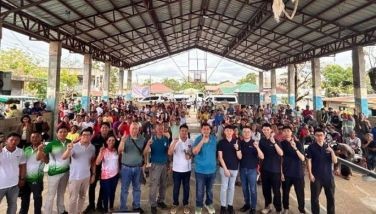the way we were
August 10, 2003 | 12:00am
 Millions of vintage photos have survived from the 19th and early 20th centuries, but only a few of these have either aesthetic or important historical value.
Millions of vintage photos have survived from the 19th and early 20th centuries, but only a few of these have either aesthetic or important historical value.
Fortunately I happened to be planning a visit to San Francisco and had a chance to view the collection first hand. It had been handed down to a Julie Conger by her maternal grandmother who had lived in the Philippines. Craig was right: the collection was quite impressive. Even nicer for me was the fact that Ms. Conger very generously offered to lend it to me so I could scan and catalog the images at my leisure, back home in Manila.
The story of this photo collection started 82 years ago when Leavitt Weare Thurlow and his young bride of just one week, Julienne Lore Fournier, set sail for Manila from California on December 6, 1911. He was American, a graduate of the Massachusetts Institute of Technology and had been working as a chemist for Great Western Sugar in Loveland, Colorado. She was French and had immigrated to the United States four years before they were married.
On arriving in the Philippines the Thurlows settled in Iloilo where Leavitt worked for the United States Bureau of Science upgrading local sugar refineries. They subsequently moved across the Guimaras Strait to Negros Occidental and lived for three years in Kabankalan on the San Isidro hacienda 100 kilometers south of Bacolod. Eventually they moved to Manila before returning to the United States in 1922.
The couple had two children while living in the Philippines, a boy and a girl, and another girl after returning to Los Angeles. As a keepsake of her years in the Philippines, Julienne Fournier Thurlow put together a collection of over 300 photographs from all areas of the country.
Over 130 of these are beautiful 5x7 black and white photographs produced by the Bureau of Science. There are also nine large images of tourist sites such as the rice terraces and other scenic views. The rest are small snapshots and postcards, and pictures taken while they were on vacation in different parts of the country. Between 1911 and 1922 the Philippines was considerably more peaceful and probably safer than today.
The Bureau of Science photos are the best in the collection and undoubtedly are the work of a professional photographer. The majority of these were probably taken by the Bureau’s first director Charles Martin.
The earliest of these photographs were made from glass plate negatives around the turn of the century. Martin and other intrepid photographers would load crates of cumbersome photographic equipment on horses or mules and go off on documentary field trips to distant provinces. These early field photographers had to work in extremely difficult conditions, with negatives which required painfully long exposure times. They did not have the advantage of electric flash for indoor shots and many of their subjects in the field had never posed for a camera before.
A good number of these photographs in the Thurlow collection are copy prints made from these original early photographs. Soon after the turn of the century, older photos were often re-photographed in order to make copy-negatives using Kodak’s new invention, photographic film. These new negatives were then used to make additional paper prints.
Charles Martin was the most important American photographer working in the Philippines after the Philippine American War officially ended in 1901. He was appointed the first official photographer for the Bureau of Science soon after civil government was re-established. He held the post for at least six years, possibly longer.
He had accompanied noted anthropologists Dean Worcester and Albert Jenks on excursions all the way from Northern Luzon to Southern Mindanao. Dean Worcester was a member of the First Philippine Commission and later served as Secretary of the Interior in the colonial government.
Worcester and Martin each took thousands of photographs in all areas of the country. Many of these were displayed at the St. Louis Exposition in 1904, along with actual people who were recruited from various regions and from the more exotic tribes.
Some of these individuals appear in the ethnographic photographs in the Thurlow Collection. Bulon, the handsome young Bagobo "chief", who was famous at the St. Louis Exposition for his luxuriant waist- length hair, appears in all his tribal finery. These early photographs taken by Martin and Worcester would have been on file with the Bureau of Science when the Thurlows arrived in Manila in 1911.
It was the aim of the American colonial government to document every aspect of America’s new "possessions." Thousands of government photographs were systematically produced; many were used for the four-volume Philippine census of 1904 and in the voluminous annual reports published by the Philippine Commissioners. Some of the images taken by Martin were also used to make artificially colored postcards for sale to tourists. Martin had been in the postcard business in Manila as early as 1898.
Although many of the images are very beautiful aesthetically, especially the ethnographic portraits, the real value of a collection such as this lies in the tremendous amount of detailed information it has preserved. Conservation architects can see exactly how the walls of Paoay Church or Intramuros were finished at the turn of the last century and how cogon grass was used in roof construction on Batanes. Designers and anthropologists alike can see examples of abaca weaving on Bagobo or Mandayan skirts and jackets, which no longer exist today. Ecologists can see actual pictures of the bountiful flora and fauna on Tubattaha Reef or the tropical rain forests of Negros, which are now environmentally threatened.
Many of these photos illustrate the early methods of sugar making, tobacco and rice cultivation, hemp manufacturing and local crafts like pottery making, weaving and spinning. For social historians there are pictures of the newly opened American trade schools, model prisons, a fascinating shot of an opium den and American soldiers trying to police Mindanao. Each picture opens a silent window on the past.
There are also images of famous Philippine landmarks, scenic views, volcanic eruptions, annual floods, locust swarms, etc. Exotic sites, from an American point of view, such as cock fighting, dog eating, head hunting, tropical vegetation and the ubiquitous carabaos in their wallows are all documented. Although taken by foreigners who came to the Philippines with their own set of cultural values and prejudices, the sheer breadth of the documentation (well over 18,000; the archives were unfortunately burned during World War II) has created an invaluable archive for future generations of Filipinos.
The Thurlow collection adds more pieces to the puzzle of Philippine history. As 21st century global culture rapidly overwhelms the indigenous cultures of nations big and small, it is vitally important to preserve as much of the Philippine’s unique culture as possible. These photographs are a wonderful teaching aid and resource for historians. Without a well-documented knowledge of their history and beautiful photographs such as these to illustrate it, young Filipinos will grow up with a shallow and ambivalent sense of their own national identity.
The Thurlow collection has now been cataloged and scanned and hopefully will soon be available to anyone eager for a first-hand glimpse of the country almost one hundred years ago. Special thanks are due to the Thurlow descendants who preserved the collection over the years and now plan to make it available to the public.
BrandSpace Articles
<
>
- Latest
- Trending
Trending
Latest













